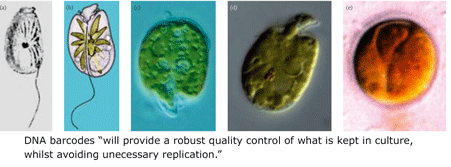“Why every protist needs a barcode”
In February 2007 Microbiology Today, scientists report on the Barcoding Protists Workshop held in Portland, Maine in November 2006, which was attended by 40 protist experts from 12 countries (Australia, Canada, Denmark, France, Germany, Japan, Malaysia, Netherlands, Norway, Russia, UK, and USA). The workshop was co-sponsored by the US National Center for Culture of Marine Phytoplankton and the UK NERC Culture Collection of Algae and Protozoa.
According to Williamson et al, “most original descriptions for [over 200,000 named] protist species are based on light microscopy and ink drawings, not only making species identification for some groups an inherently subjective and specialist occupation, but also potentially hiding major genetic diversity.”

Workshop participants agreed unanimously that “to help resolve many of the contradictions and uncertainties in protist taxonomy, genetic barcoding is the way forward, starting with material, particularly type strains, in internationally recognized culture collections.”
This entry was posted on Tuesday, February 13th, 2007 at 11:03 pm and is filed under General. You can follow any responses to this entry through the RSS 2.0 feed. Both comments and pings are currently closed.